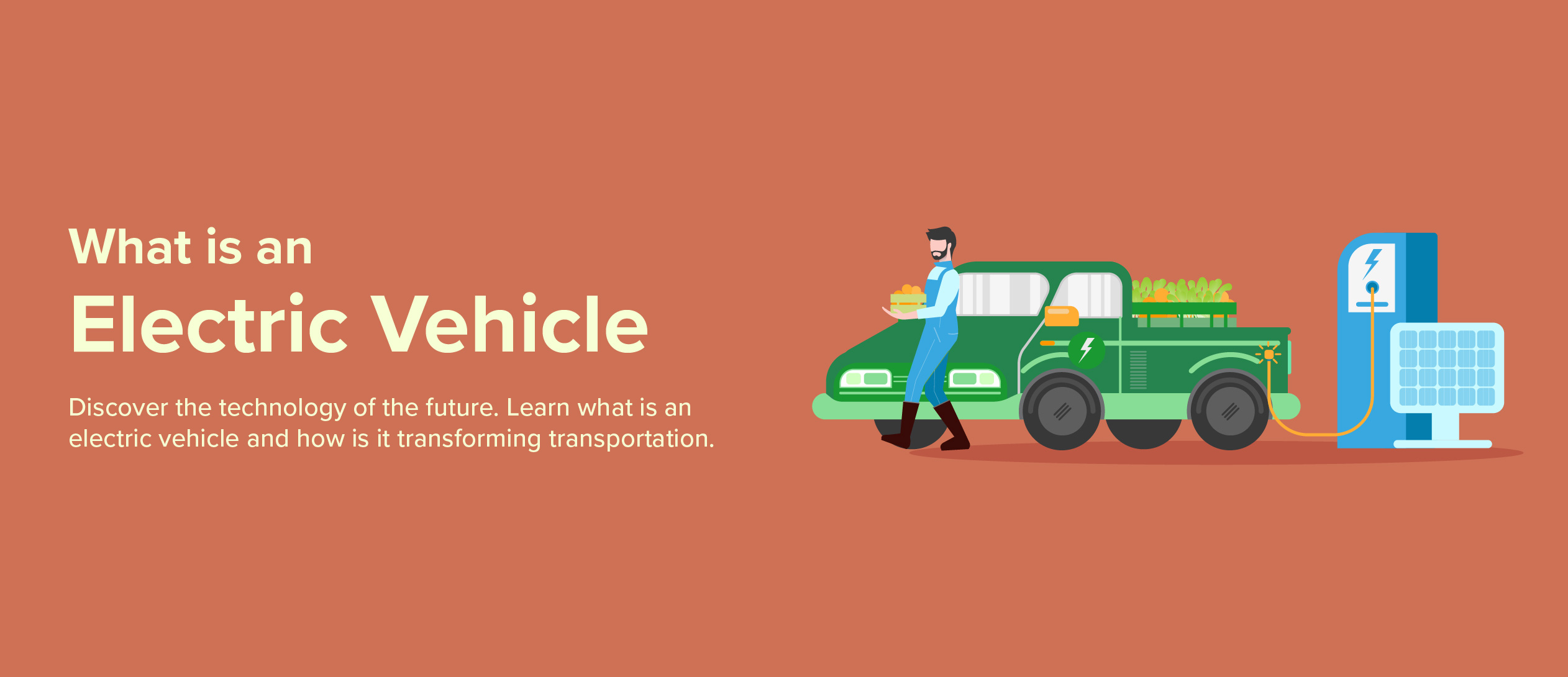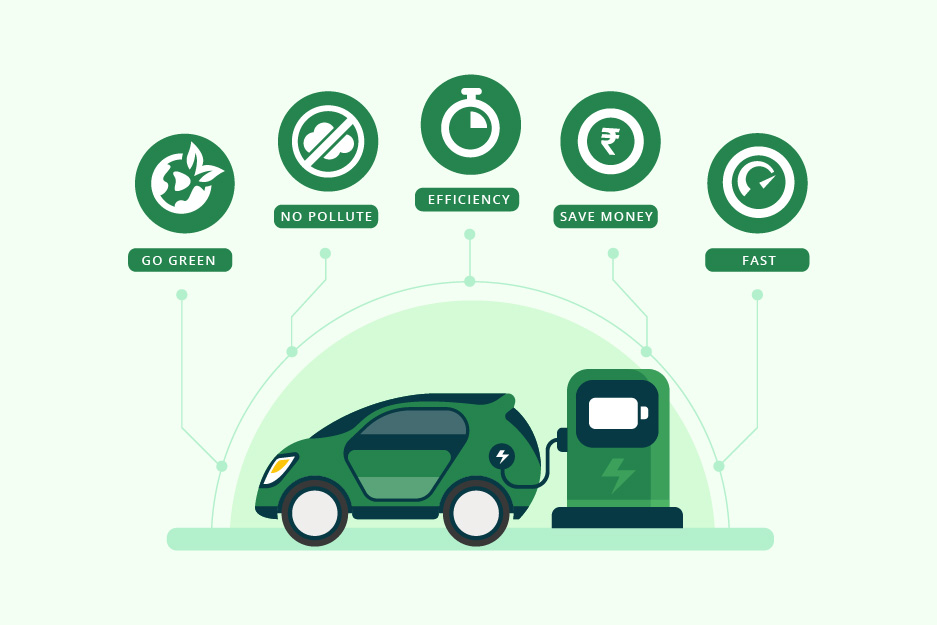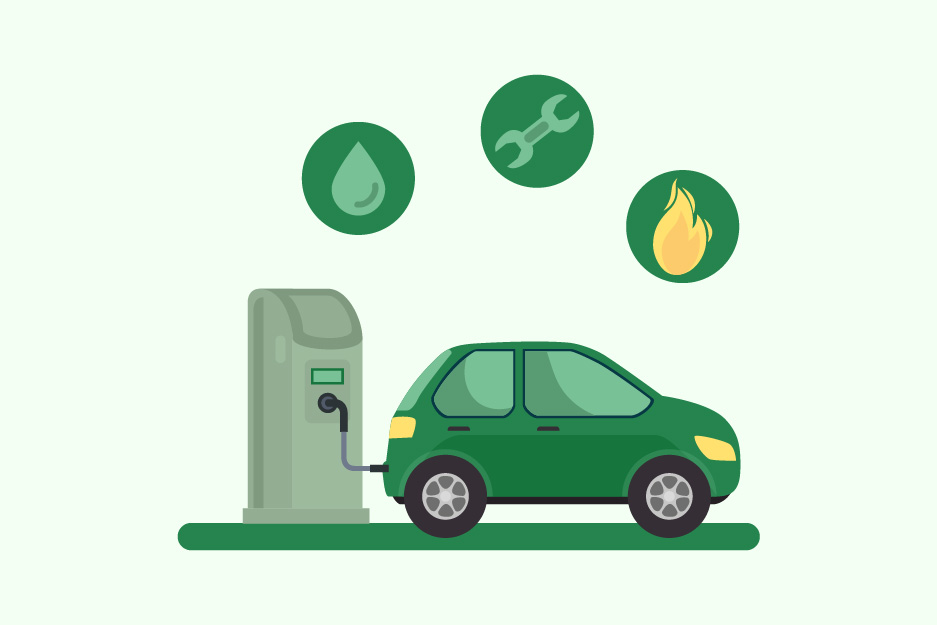What is an Electric Vehicle? – Types, Components, Advantages, & More
According to data, the demand for electric vehicles is expected to grow by 23% during 2023 – 2032. As people become more aware of the sustainable environment and how their activities affect it, the popularity of electric vehicles will increase significantly. Many countries and auto manufacturers have launched a list of electric vehicles that will help us to go all-electric by 2040. In a bid to achieve this, countries have started developing roads that charge electric vehicles. In this blog, we will look at What is an Electric Vehicle? its types, components, and more.
Introduction to Electric Vehicles
An electric vehicle is powered by electricity instead of running on traditional engines burning petrol or diesel. It is run by one or more electric motors that are powered by rechargeable batteries. They use electricity stored in these batteries to generate power. Electric vehicles can also use regenerative braking to create electricity and recharge the batteries. EVs are considered zero-emission vehicles because they can only run on electricity and are three times more efficient than traditional vehicles.
EVs are considered zero-emission vehicles because they can only run on electricity and are three times more efficient than traditional vehicles.


History of Electric Vehicles
Electric cars have a long history, beginning as early experiments in the 1830s by inventors from Hungary, The Netherlands, the UK, and the US. William Morrison’s practical EV of 1890 marked an important milestone. However, EVs became less prominent after the 1973 oil crisis and growing climate concerns.
Happily, modern EVs re-emerged in the late 20th century with hybrids such as Toyota Prius. The 2010 Nissan Leaf was one of the first mass-marketed electric vehicles that paved the way for exponential growth. Electric car sales have grown exponentially since 2012 and now account for one in seven cars sold globally.
Types of Electric Vehicles
There are several types of electric vehicles. Some of them are as follows.
Battery Electric Vehicles (BEV)
BEVs, or battery electric vehicles, run entirely on electricity. They feature a sizable battery that powers the electric motor. They can be charged by plugging into a regular charging outlet or facility. BEVs are the cleanest type of electric cars because they have no combustion engines and therefore do not produce any fumes.
Hybrid Electric Vehicles (HEVs)
A hybrid electric vehicle has a fuel engine and an electric propulsion system. It combines an internal combustion engine (ICE) with an electric motor and battery system. The electric motor supplements the internal combustion engine (ICE) during acceleration and cruising. Together, the two power sources provide propulsion.
Plug-In Hybrid Electric Vehicles (PHEVs)
PHEVs, also called plug-in hybrid electric vehicles, are similar to HEVs, but feature a bigger battery that can be charged by plugging into an outlet easily. This enables them to run exclusively on electricity for a short period before switching to an ICE engine. PHEVs can operate in a hybrid or an electric-only mode, making them more adaptable than HEVs.
Fuel Cell Electric Vehicles (FCEVs)
In fuel cell electric vehicles, the electric motor is powered by energy produced by hydrogen. They produce no emissions except heat and water vapor. They are less feasible than other types of electric cars. This is because of the limited infrastructure for manufacturing and delivering hydrogen.
To learn more about EVs, you can opt for an electric vehicle course which will help you understand this new growth sector.
Components of an Electric Vehicle
Electric vehicles have fewer moving parts as compared to traditional vehicles. The components of an EV are as follows.
- Battery Pack: A battery pack is also called an electric vehicle battery (EVB). It fuels an electric vehicle’s motors and works as a form of power storage. The energy is stored in the form of DC. The range increases with the increase in the kW of the battery.
- DC/DC Converter: It helps control the electricity flow between the battery and other components in the car. An electric motor is driven by a high-voltage direct current (DC). Other car systems, however, need a lower voltage DC power supply. The converter helps lower and regulate the voltage so that it can be used by other systems in the car as well.
- Electric Motor: This is the main component of an EV, and helps the car to run. It transforms electric energy into mechanical energy. A regenerative braking system is an important feature of electric motors. It helps to slow down the vehicle by converting the kinetic energy back into electrical energy.
- Power Inverter: The power inverter helps convert the direct current (DC) from the battery into an alternate current (AC), which powers the electric motor.
- Charging Port: It helps the vehicle to connect to an external power supply to charge the battery. The port can be located at the front or back of the vehicle.
- Onboard Charger: An onboard charger helps convert the AC from a charging source into a DC stored in the battery. It is located inside the vehicle and helps in regulating the current.
- Auxiliary Batteries: In some vehicles, there is a supplement battery known as an auxiliary battery. It powers auxiliary systems and components. It also helps in powering systems such as lights, entertainment systems, power windows, etc.
- Thermal System: The thermal system helps regulate the temperature of the battery and other components. This helps prevent unforeseen damages and gives an efficient output.
- Transmission: It transfers energy from the motor to the wheels to help the car move. Electric vehicles generally have a single-speed transmission compared to conventional cars.


How Do Electric Vehicles Work?
Electric cars use an electric motor rather than a traditional internal combustion engine to convert electrical energy into mechanical energy and subsequently create kinetic power, allowing the car to move. This is comparable to how automatic vehicles function. Motion is possible when you either “drive” or “reverse”. Pressing the accelerator pedal sends a signal to the controller, which then passes it along to an inverter. The inverter changes DC power from the battery into AC and sends it to the motor so that vehicle speed can be controlled properly.
Electric cars are powered by electricity stored in rechargeable batteries. This is accessed by plugging into a charging station, allowing for rapid acceleration and a light driving experience compared to vehicles with traditional fuel engines. Some also use motor generators that both drive the vehicle and regenerate power back onto the grid.
Electric Vehicle Companies in India
The following are some popular electric vehicle companies in India.
1. Mahindra Electric
Mahindra was the first to bring electric vehicles (EVs) to India with its launch of Mahindra Reva in 2001. Since then, it opened up a research and development center in Bengaluru and expanded its EV range with additional models like the E20 and eVerito. To further expand EVs’ presence across India, they partnered with different institutions for setting up charging points around the country.
2. Tata Motors
Tata Motors is India’s biggest car maker and produces cars, SUVs, buses, trucks, and military vehicles. Its related firms are Jaguar Land Rover and Tata Daewoo. It has a joint venture with Fiat as well as 4 R&D centers to develop efficient auto tech for EVs. They include e-cars (Nexon EV, Tigor EV, Nano EV & Tiago electric variant) and electric buses. To help infrastructure development, they are also setting up charging stations in the country.
3. Ather Energy Private Limited
Ather Energy is an Indian startup that produces electric scooters. Their goal is to create a more eco-friendly way of transportation in India, which currently relies heavily on petrol and diesel-powered vehicles. They offer high-quality electric scooters with great riding experiences for their customers along with investing in charging infrastructure to support the rising need for EVs in India.
4. Ashok Leyland
Ashok Leyland, part of the Hinduja Group, is one of the top four bus makers in the world and also a leading truck maker in India. It has partnered with Sun Mobility to expand its vehicle skillset. Ashok Leyland creates electric options suited for Indian markets as well as battery swap technology for buses that meet e-mobility needs in India. They released multiple variants, such as Circuit, HYBUS, and Electric Euro 6 Truck while announcing iBUS too. However, currently, they are more focused on expanding exports.
5. Bajaj Auto Limited
Bajaj Auto is a leading manufacturer of two-wheeled vehicles, such as motorcycles, scooters, and three-wheelers. It has an international presence in over 75 countries and offers innovative products for all customer segments. The company recently began making electric vehicles with the introduction of electric scooters and motorcycles to the Indian market.
Advantages of Electric Vehicles
There are several advantages of an electric vehicle. Some of them are as follows-
- Low Maintenance Costs
Electric vehicles have lesser moving parts as compared to conventional vehicles. This helps lower the overall maintenance cost. No refueling is required in an EV, which further helps save money.
- Noise Free
Electric vehicles are silent as there is no engine. This helps in a more peaceful and smoother driving experience. Additionally, it helps in reducing noise pollution.
- Environment Friendly
As an electric vehicle operates totally on an electric motor and there is no combustible engine in an EV, it produces zero emissions while driving. This helps in reducing air pollution.
- Government Benefits
Considering the future of electric vehicles in India government started offering tax subsidies on purchasing electric vehicles, which help in making them a little more lucrative for the customer to buy. These incentives may lower the price of buying an EV and increase its availability to more users.
Disadvantages of Electric Vehicles
Though electric vehicles have become popular, they have several disadvantages too. These include:
- Limited Range
Electric vehicles have a limited range, generally up to 300 miles on a single charge. This is a concern for people who wish to travel longer distances.
- Charging Time
The charging time taken by EVs is a lot. Though some charging stations can charge it in 60 minutes, many take close to 3-4 hours for a full charge.
- Limited Infrastructure
With the recent growth in the EV sector, charging stations have come up, but they are still fewer compared to gas stations. This is a major concern for drivers to find charging stations while going to a different city or on long trips.
- High Upfront Cost
Electric vehicles have a much higher cost than conventional gas vehicles, which can be a barrier for many people looking to buy EVs.
Future of EVs
The future of electric vehicles looks promising. If we switched to hybrids or electric cars, it could reduce foreign oil dependency and decrease transportation sector emissions. EVs are becoming increasingly available and widely accepted, with diesel-reliant vehicles declining in popularity. This shift is being driven by decreasing costs of EVs as well as increased model options and charging infrastructure development.
Advances in AI have also improved battery testing capabilities for hybrid electric cars (HEVs), which combine an internal combustion engine with an electric one to reduce emissions while still providing fuel efficiency benefits over traditional gasoline-powered engines. Using electric instead of gas-powered vehicles can help the environment. But we still need to figure out how to make sure these EVs are powered by clean and renewable sources in order to meet future demand.
Electric Car Vs Petrol Car
Choosing between electric and petrol cars is now more complicated due to the increasing popularity of electric vehicles. With gas prices going up and pollution at an all-time high, people are increasingly keen to try out EVs. Here’s a comparison of both types so you can make an informed decision about which one fits your needs better.
| Parameter | Electric Cars | Petrol Cars |
| Source of Power | Electric cars use electricity stored in batteries for their power source. | Petrol cars are powered by an internal combustion engine that uses either gasoline or diesel fuel. |
| Buying Cost | The buying price can start from ₹ 4.5 lakhs. | The buying price starts from ₹ 2 lakhs. |
| Cost of Maintenance | Electric cars have lower running costs than petrol cars due to the low cost of electricity and fewer moving parts that need regular maintenance. | Petrol vehicles tend to be more expensive as they require more frequent servicing and fueling is typically higher as compared to electric power sources. |
| Range | The distance an electric car can travel on one charge is between 200 and 490 kilometers. | A petrol-powered car will cover approximately 20 km for every liter of fuel consumed. |
| CO2 Emissions | Lower carbon dioxide emissions. | Higher carbon dioxide emissions. |
| Running Cost | The expense of driving an electric car is between ₹ 1 and ₹ 2 per kilometer. | The cost of a petrol car is approximately ₹ 4 per km. |
Conclusion
The move towards electric vehicles has started. Buying an electric car has its benefits and helps in saving costs. Despite a few challenges, the EV market is expected to grow in the coming years as the technology becomes more sophisticated. If you have any more questions on what is an electric vehicle, leave them in the comments, and we’ll be happy to answer.
FAQs
The escalating effects of climate change and the alarming level of air pollution have necessitated a search for clean energy solutions. Due to this reason, the introduction of EVs in India should be welcomed with open arms.
Some of the best electric vehicles in India are Tata Tigor EV, Mahindra XUV400, Tata Nexon EV max, MG ZS EV, Tata Nexon EV Prime, Hyundai Kona Electric, Audi e-tron Sportback, etc.
Electric vehicles (EVs) are generally cheaper than petrol cars in the long run as they require less maintenance and their fuel (electricity) tends to be cheaper than petrol or diesel costs.
The biggest issue that comes along with owning an electric vehicle (EV) is battery-related issues. This can include reduced capacity or failure due to age, overuse, and even weather conditions.
Lithium-ion (Li-ion) batteries are used in electric vehicles.
On average, the battery life of an electric vehicle can range from 10 to 20 years.
The cost of an electric vehicle battery can range in price from $4,000 to $20,000. This may be affected by the age, brand, and type of your automobile.
It costs about $4,000 to $20,000 to replace an electric car battery with a new one.
The size of the Indian electric vehicle market was estimated to be USD 1.45 billion in 2021 and is projected to expand from USD 3.21 billion in 2022 all the way up to a whopping value of USD 113.99 billion by 2029.







